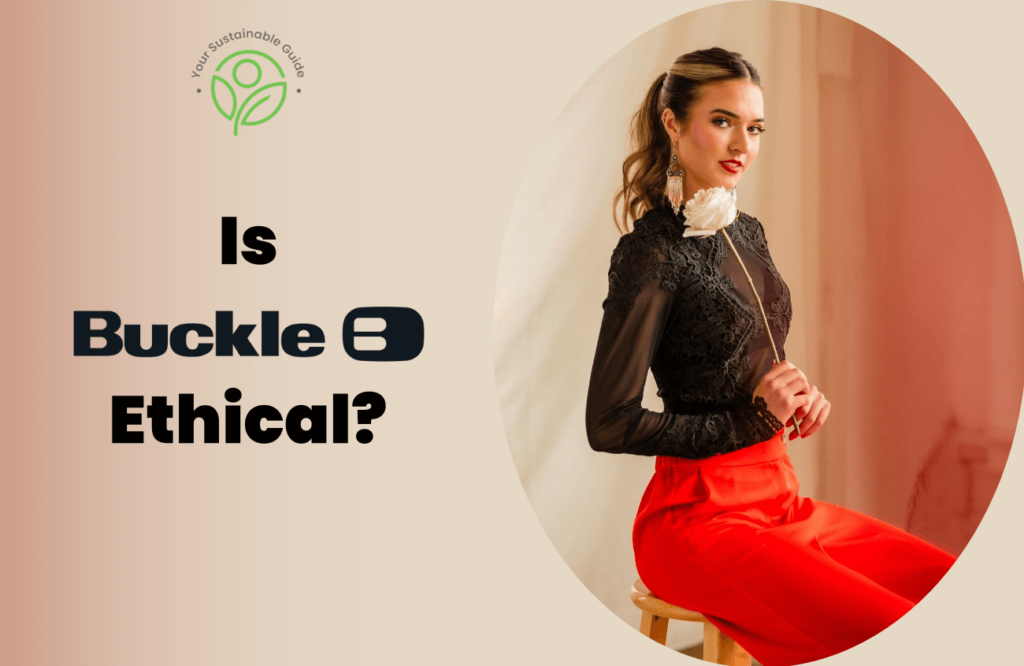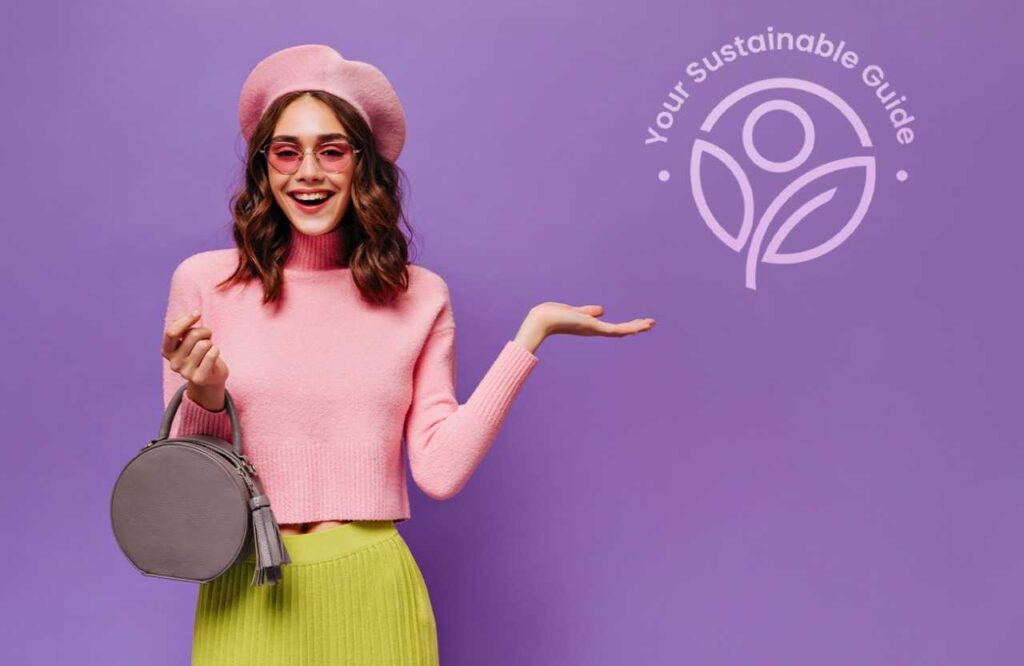Fashion, the ever-evolving world of style and glamour, carries a hidden cost that we can no longer ignore. With its fast-paced trends and insatiable demand, the fashion industry has left a permanent mark on our planet. From toxic synthetic textile production to mountains of discarded garments, the environmental impact is staggering. But amidst the chaos, circular fashion can be our hope!
This revolutionary concept is designed to wipe out the status quo of the linear fashion model, offering a solution where textile waste becomes a thing of the past. Are you ready to join the movement where circular fashion brands stand as the future of fashion? Let’s dive right in!
- What is Circular Fashion?
- History of Circular Fashion: How it All Started…
- Difference Between Linear, Recycling, and Circular Economy in Fashion Industry
- Important Components of Circular Fashion
- Design for Longevity
- Sustainable Materials and Practices
- Repair, Refurbish, and Upcycle
- Recycling and Adoption of Closed-loop Systems
- Collaborative Efforts Across the Supply Chain
- Environmental Benefits of Circular Fashion
- Reduction in Textile Waste
- Conservation of Natural Resources
- Reduction in Carbon Emissions
- Preservation of Biodiversity
- Promotion of Sustainable Farming and Ethical Practices
- Less Pollution
- Why Do We Need Circular Fashion?
- Contributions to the Cause of Circular Fashion
- Examples of Circular Fashion
- Busting the Myths About Circular Fashion
- 5 Best Brands that Have Embraced Circular Fashion
- Brands Greenwashing Under the Guise of Circular Fashion
- To Sum it Up…
What is Circular Fashion?
Circular fashion refers to an innovative technique that aims to create garments in a closed-loop system, using the existing resources in the fashion industry. It starts right from the initial design stage, where careful consideration is given to producing clothing with durability, versatility, and the ability to be repurposed or recycled. This process focuses on fabricating, and utilizing garments in a way that maximizes their lifespan, minimizes waste, and reduces environmental impact.
The core principles of circular fashion revolve around longevity, recycling, and regenerative practices. It promotes well-made and durable timeless clothes that can be used for years. Next, it celebrates the concept of recycling as a means to give new life to discarded garments. Recycling involves breaking down used textiles and deadstock fabrics to create raw materials that can be used in the production of new garments. This helps to reduce the demand for virgin resources, cutting out the devastating impact associated with the extraction and production of fresh materials.
Furthermore, circular fashion emphasizes regenerative practices that focus on replenishing and restoring ecosystems impacted by the fashion industry. This involves adopting sustainable sourcing methods, supporting organic farming, and investing in technologies that reduce pollution and waste.
The shift towards a circular economy in the fashion industry is crucial to address the ongoing environmental and social challenges posed by the linear model of production and consumption. It promotes resource efficiency, reduces waste generation, and encourages a more sustainable and ethical fashion ecosystem.
History of Circular Fashion: How it All Started…
Circular fashion has roots in various movements and theories that have evolved over time. It draws inspiration from concepts such as upcycling, recycling, and cradle-to-cradle design principles. The Ellen MacArthur Foundation played a pivotal role in popularizing the idea of a “Circular Economy” and its application to the fashion industry. It was introduced in the early 2000s and provided a framework for rethinking the entire lifecycle of fashion products. Influenced by the idea, Anna Brismar coined the term “Circular Fashion” in June 2014, during a sustainable fashion event in Stockholm, Sweden.
The emergence of technology and digital platforms accelerated the evolution of circular fashion. Online marketplaces and apps for swapping, reselling, and sharing clothing gained popularity, facilitating the transition to a more circular economy. The fashion industry’s increasing focus on sustainability, driven by consumer demand and environmental concerns, has led to collaborations between brands, organizations, and governments to promote circularity.
Today, the circular fashion model is a dynamic and evolving field. It encompasses diverse approaches, such as closed-loop production systems, maintenance and repair services, and the integration of renewable and recyclable materials. Influential movements like the “Fashion Revolution” campaign have raised awareness about the social and environmental aftermath of fashion, calling for greater transparency and accountability throughout the fashion supply chain.
Difference Between Linear, Recycling, and Circular Economy in Fashion Industry
Linear Economy
The linear economy operates on a simple principle: “Take, Make, and Dispose.” Resources are extracted from the Earth’s core, transformed into products, and eventually discarded as waste. This approach is super convenient for most industries, but it comes with significant drawbacks. It leads to resource depletion, environmental degradation, and waste accumulation. It is commonly practised by most fast fashion brands and perpetuates a never-ending cycle of consumption without considering the long-term consequences on our planet.
Recycling Economy
This economy focuses on the collection and transformation of waste materials into new products. It aims to minimize waste, conserve finite resources, and decrease the environmental impact of traditional linear production systems. In a recycling economy, materials that would otherwise be discarded as waste are diverted from landfills and reintroduced into the production cycle. However, this process has its own limitations. To start with, recycling requires a substantial amount of energy, water, and other resources. Due to technological constraints or lack of advanced recycling technologies, not all materials can be effectively recycled. Additionally, this process alone does not address the root causes of resource depletion or promote sustainable consumption.
Circular Economy
The circular economy comes out as a one-stop solution for every commercial sector. In terms of the fashion industry, circular fashion is designed on the concept of making clothes that last, fixing and reusing them, and finding new ways to recycle and repurpose them. By keeping things in use for as long as possible, we can cut down on textile waste, save resources, and make a positive impact on the environment. Circular fashion is all about being smart and sustainable. It fosters green strategy production methods, responsible consumption, and reuse ideologies, while also encouraging innovation and the development of a more resilient and environmentally conscious fashion industry.
Important Components of Circular Fashion
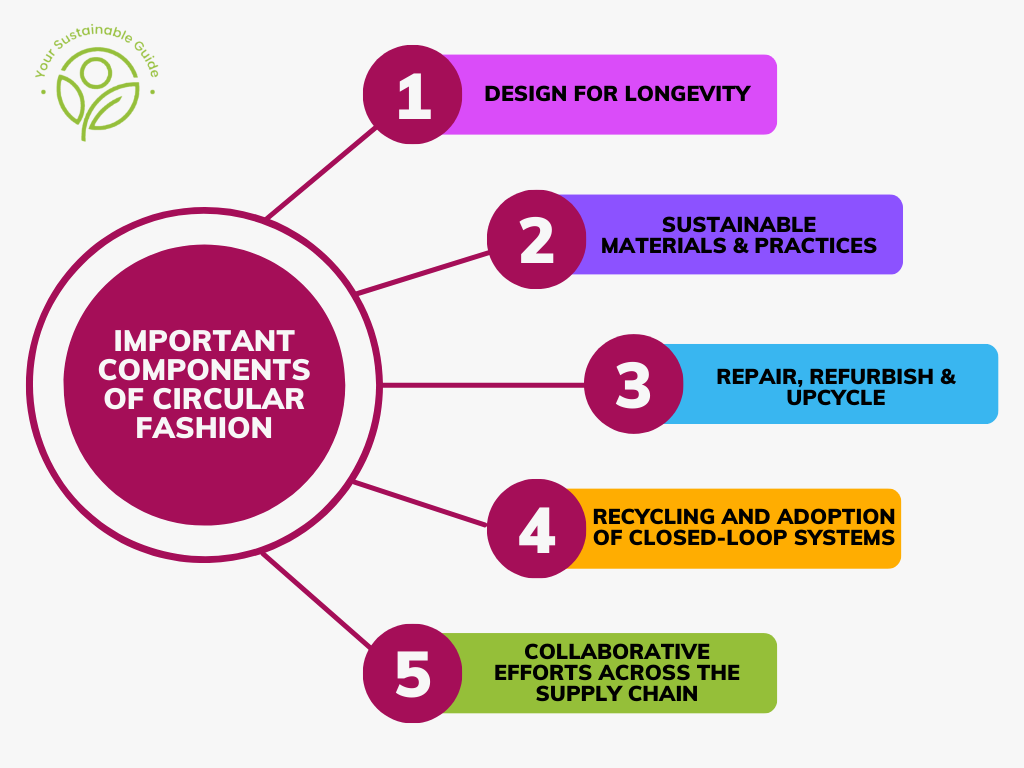
Circular fashion incorporates several fundamental components to foster a sustainable and regenerative approach to the fashion industry.
Design for Longevity
This approach involves creating long-lasting, timeless, and high-quality garments that can withstand multiple uses and changing trends. The goal here is to reduce the frequency of disposal and encourage the reuse of clothing items.
Sustainable Materials and Practices
The use of sustainable materials and processes is essential to carve a low-impact clothing industry. It covers ideas like opting for eco-friendly fibers, such as organic materials or recycled fabrics and implementing environmentally conscious production methods that minimize resource consumption and pollution.
Repair, Refurbish, and Upcycle
This practice involves repairing and upcycling existing garments to extend their lifespan instead of discarding them for minor damages. Repairing garments allows us to mend tears, fix broken zippers, or replace missing buttons, ensuring that they can be worn for longer periods. On the other hand, refurbishing calls for giving new life to old or worn-out clothing. This may require dyeing or printing over-faded fabrics, adding embellishments or patches to refresh the garment’s appearance, and so on. And upcycling is about taking your creativity to the next level by transforming unwanted garments into entirely new pieces.
Recycling and Adoption of Closed-loop Systems
Recycling serves as a key component of circular fashion, as it reduces the need for virgin resources and minimizes waste. It involves repurposing materials from old or discarded garments and incorporating them into new fashion products. Now, a closed-loop system is a part of the recycling practice in the circular fashion scenario. It ensures that materials can be continuously recycled and reintegrated into the production cycle, creating a sustainable loop.
Collaborative Efforts Across the Supply Chain
Joint efforts across the supply chain is about bringing together brands, manufacturers, suppliers, and consumers to work together to create a circular fashion ecosystem. This collaboration involves sharing knowledge, resources, and best practices to drive innovation and create a more sustainable clothing industry as a whole.
Environmental Benefits of Circular Fashion
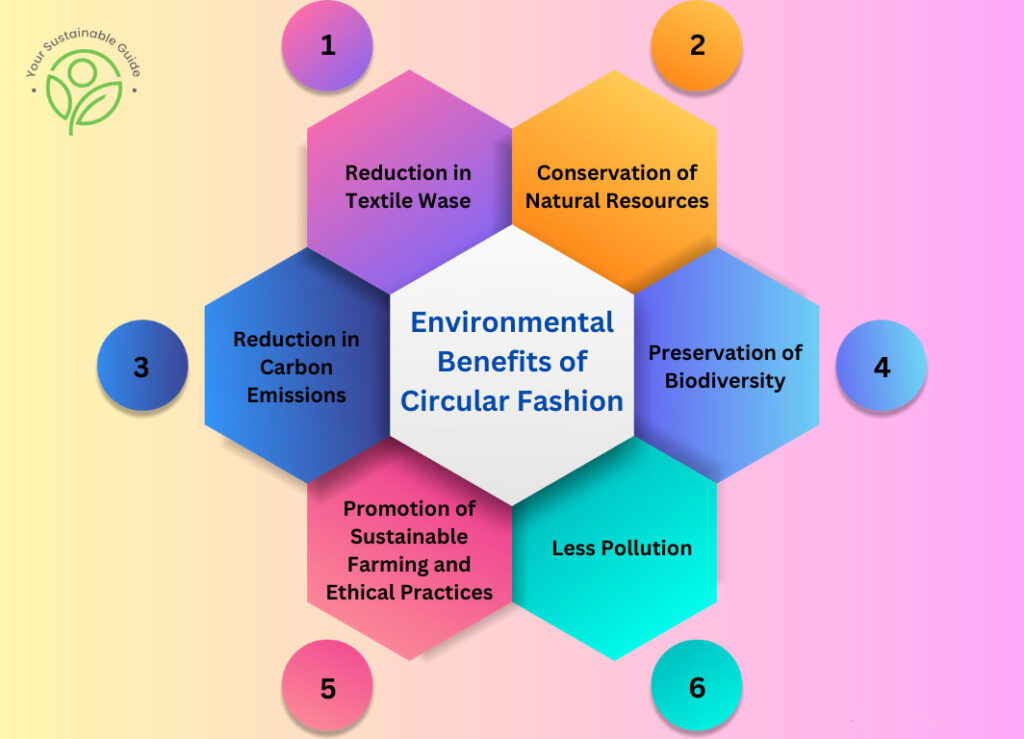
There are numerous environmental benefits of circular fashion which are indispensable in creating a cleaner and greener fashion industry.
Reduction in Textile Waste
The circular approach is built on the goal of cutting out textile waste by repurposing materials and transforming old garments into new ones, reducing the need for disposal in landfills or incineration.
Conservation of Natural Resources
It promotes the efficient use of resources by encouraging practices like utilizing recycled materials, water-saving techniques, and so on, in production and energy-efficient processes. This helps safeguard precious resources and reduces the environmental footprint of the fashion industry.
Reduction in Carbon Emissions
Circular fashion approaches helps mitigate climate change by lowering carbon emissions associated with the production, transportation, and disposal of clothing. Repurposing materials require less energy-intensive processes, leading to a smaller carbon footprint.
Preservation of Biodiversity
It encourages the use of sustainable materials and production methods that have minimal impact on ecosystems. This helps protect biodiversity and ensures the long-term health of our planet’s natural resources.
Promotion of Sustainable Farming and Ethical Practices
Brands that have implemented a circular fashion system supports the use of organic and fair-trade materials, promoting regenerative farming practices that prioritize environmental stewardship and fair treatment of workers.
Less Pollution
Circular fashion businesses use non-toxic and eco-friendly materials, minimizing the use of harmful chemicals that goes into the production and processing of clothing. This way, they can eliminate their contribution to air, water and soil pollution, which are important aspects for protecting human health and that of the planet.
Why Do We Need Circular Fashion?
The need for circular fashion has become increasingly urgent in addressing the environmental and social challenges posed by the linear fashion industry. This linear model, which follows a take-make-dispose approach, has made detrimental effects on the planet and communities. Apart from excessive resource consumption, it contributes to significant greenhouse gas emissions, wastewater generation, and massive amounts of textile waste ending up in landfills. Moreover, it maintains a system of fast fashion that relies on cheap labor and results in poor working conditions and unfair wages for garment workers.
The fashion industry’s environmental footprint continues to grow, fueling climate change. Plus, the social implications of exploitative labor practices cannot be ignored. Workers’ rights and well-being are constantly compromised in the pursuit of fast and cheap production. However, circular fashion offers a solution by shifting to regenerative and sustainable business models. It ensures the preservation of a healthy planet by reducing carbon emissions, creating recycled products, and protecting ecosystems. What’s more, it paves the way for a more inclusive and fair industry, where workers’ rights and livelihoods are prioritized.
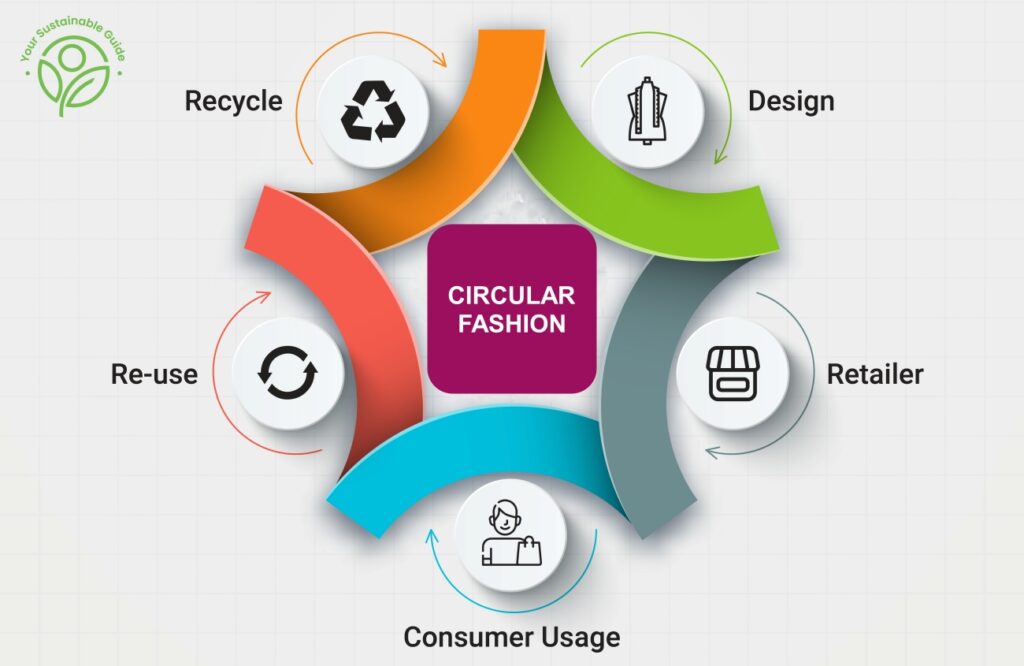
Contributions to the Cause of Circular Fashion
How Can Consumers Contribute?
Consumers play a strong role in advocating for a circular fashion industry through their conscious buying decisions and responsible actions.
- We can make sustainable purchasing choices by supporting brands and products that align with circular principles. This includes considering factors such as material sourcing, durability, and ethical production practices.
- Adopting alternative practices like clothing rental, swapping, and second-hand shopping is another great idea to incorporate circular fashion in our lifestyle. Renting clothes for special occasions or participating in clothing swap events reduces the demand for new garments and encourages a more sustainable sharing economy.
- If in doubt, seeking out certifications and labels that signify eco-friendly and circular fashion practices when making purchasing decisions works as the safest guideline.
- Many Earth-friendly fashion brands have “Take-Back” programs, which simply means they’ll take back your old and used garments bought from that particular label and recycle them. Try to make the most of it and participate in such programs to responsibly get rid of clothes you no longer want.
- Let’s learn to take care of our garments to prolong their lifespan. The best way is to follow care instructions on the clothing labels, mend or repair clothing when needed, and avoid excessive washing and drying. By treating garments with care, we can minimize waste and maximize their usage.
- In case of decluttering, try to properly dispose of your clothing. We can recycle garments made from recyclable materials or donate them to charities or thrift stores. This ensures that clothing stays in circulation and reduces the amount of textiles ending up in dumpyards.
How Can Businesses Contribute?
As conscious consumers, we can create demand for responsible circular fashion, but ultimately it’s the big businesses who have the power to make this concept real.
- Fashion brands can implement sustainable and circular design principles that focus on creating durable and premium quality garments which are built to last and are recyclable.
- Embracing product lifecycle management strategies is the best way to consider the entire lifecycle of a product. From its design to its disposal, these steps prioritize maximizing the product’s lifespan.
- Incorporate recycled and upcycled materials as a major part of their product lines.
- Invest in research and development to improve circular fashion solutions and develop new sustainable materials.
- Collaborate with suppliers and manufacturers to establish closed-loop systems, decreasing waste and increasing resource efficiency for a circular fashion industry.
- Support circular economy initiatives by partnering with recognized international organizations and participating in industry-wide collaborations.
- Educate customers about the benefits of circular fashion and encourage responsible consumption.
Examples of Circular Fashion
Implementing circular business models is efficiently possible in the fashion industry. And these examples set by some amazing brands are waking proof.
Napapijri
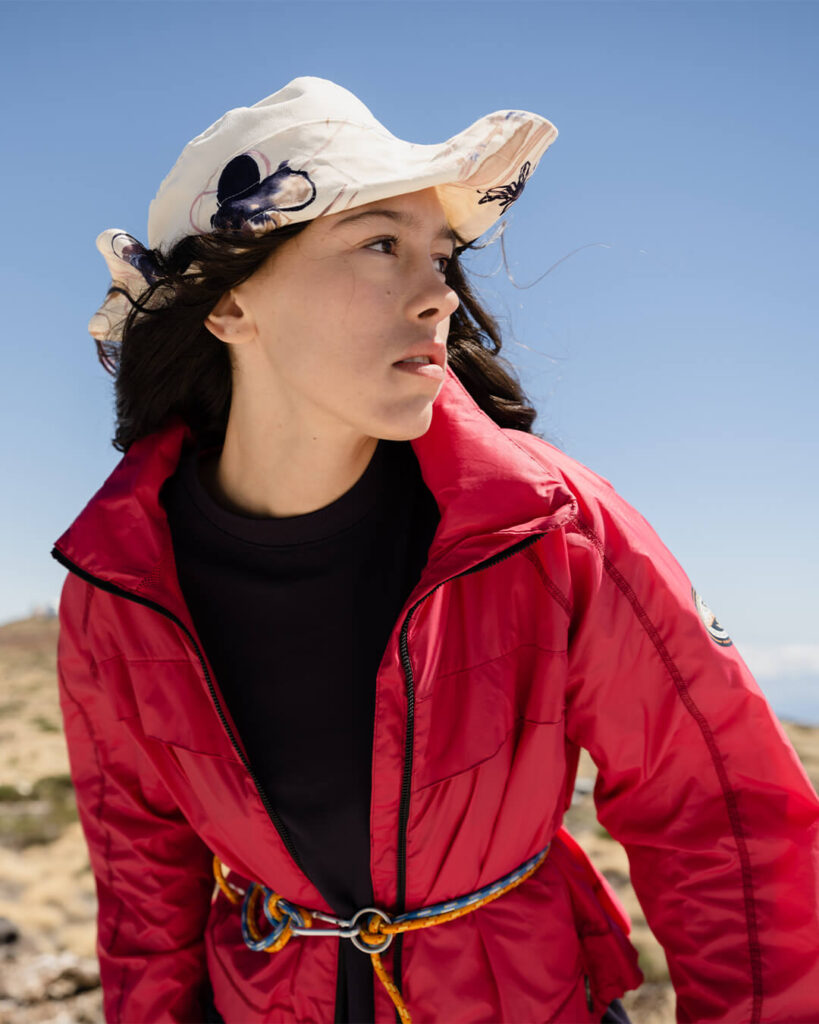
Italian clothing brand Napapijri has revolutionized the design of its high-performance jackets to foster a circular model and sustainability. Their “Circular Series Jackets” are made from a single polymer, Nylon 6, which ensures durability and excellent functionality while allowing for easy recycling. This innovative approach simplifies recycling by eliminating the need to separate multiple materials. The jackets act as a “material bank” for the future, reducing waste and reliance on new resources. Napapijri’s commitment to sustainability is further validated by the prestigious Cradle2Cradle product scorecard, which awarded their jackets with a Gold Certification for meeting criteria such as material health, water stewardship, renewable energy use, and social fairness.
To encourage recycling, customers who purchase a Circular Series jacket can register their product online and receive a 20% discount on a new item when they return their old a minimum of 2 years. Through a partnership with Aquafil, the returned jackets undergo a chemical recycling process known as depolymerization, transforming them into Econyl®, a recycled nylon. Napapijri’s circular product design approach sets an inspiring example for the fashion industry, demonstrating how innovative thinking can lead to a more sustainable future.
MUD Jeans

MUD, an innovative denim brand, has completely transformed the traditional fashion model. Instead of the usual “make, buy, wear, bin” approach, MUD offers a renting system for their jeans. Yes, you read that right! Customers can rent denims and return them to the label once they are worn out, allowing the company to repair or recycle them instead of dumping them in landfills. This circular system ensures that materials stay in use and avoids waste. MUD is also committed to sustainability by using renewable energy and advanced technology to clean up the typically toxic denim production process.
The renting process is simple. Customers lease jeans made from 40% recycled denim and 60% organic cotton for a monthly fee, with free repairs included during the lease period. After a year, customers have options to swap for a new pair and continue leasing, keep the jeans for as long as they want and return them for recycling, or end the lease and receive a voucher for a new purchase. Denims returned in good condition are cleaned, repaired if needed, and sold as vintage pieces, while those beyond repair are recycled and reintegrated into the system. MUD’s approach showcases its commitment to sustainability and its unique perspective on zero-waste fashion.
Busting the Myths About Circular Fashion
As the garment industry continues to evolve, more options and innovations are emerging, making sustainable and circular fashion accessible to a wider audience, proving that we can look good and do good for the planet at the same time. However, there are some common myths that stand in the way. It is essential to debunk them and spread awareness about the stylish and affordable possibilities of circular fashion.
Myth: Circular fashion is not stylish!
Fact: Contrary to this misconception, circular fashion can be incredibly stylish. Many sustainable and circular fashion brands have emerged, offering trendy and fashionable designs that cater to various tastes and preferences. These brands prioritize both sustainability and aesthetics, proving that style and sustainability can go hand in hand. For example, Stella McCartney, a renowned fashion designer, has been a vocal advocate for circular fashion and has successfully created stylish collections using sustainable materials and innovative design techniques.
Myth: Circular fashion is expensive!
Fact: It’s true that some sustainable fashion brands have higher price points due to their commitment to ethical production and quality materials, but circular fashion does not necessarily equate to high costs. There are many affordable options available in the market, including second-hand or vintage clothing, clothing rental services, and upcycled fashion items. Brands like Patagonia have implemented circular strategies by offering repair services for their products, extending their lifespan and reducing the need for new purchases. Additionally, circular initiatives like clothing swaps or online platforms for pre-loved fashion items like ThredUp, Depop, Poshmark, etc., provide an ocean of cost-effective alternatives.
Myth: Circular fashion is solely about recycling!
Fact: It has become a common notion that if a brand recycles, it observes circularity. However, recycling should be viewed as a last resort rather than the primary solution. Recycling techniques consume significant amounts of energy and resources, and the quality of materials often deteriorates with each cycle. So it is crucial to explore alternative avenues such as reducing consumption, reusing garments, and designing for longevity. That’s the best way clothing labels can embrace circularity and minimize waste in the fashion industry.
5 Best Brands that Have Embraced Circular Fashion
1. Patagonia

Patagonia stands out as a leader in prioritizing circularity and sustainability. With a deep commitment to environmental responsibility, it has implemented innovative practices that promote circular fashion. While the company offers everything with an Ironclad Guarantee, it encourages customers to repair their clothing by providing repair guides and facilitating repairs at its stores. Additionally, Patagonia offers the “Trade-In” option in its “Worn Wear” program, where you can return your used garments for store credit. Furthermore, the outdoor clothing label utilizes recycled materials in its garment production processes, incorporating materials like reclaimed down, recycled polyester and nylon, and many more. By demonstrating that high-performance outdoor gear can be produced sustainably, Patagonia sets a positive example for the fashion industry as a whole.
2. Tentree
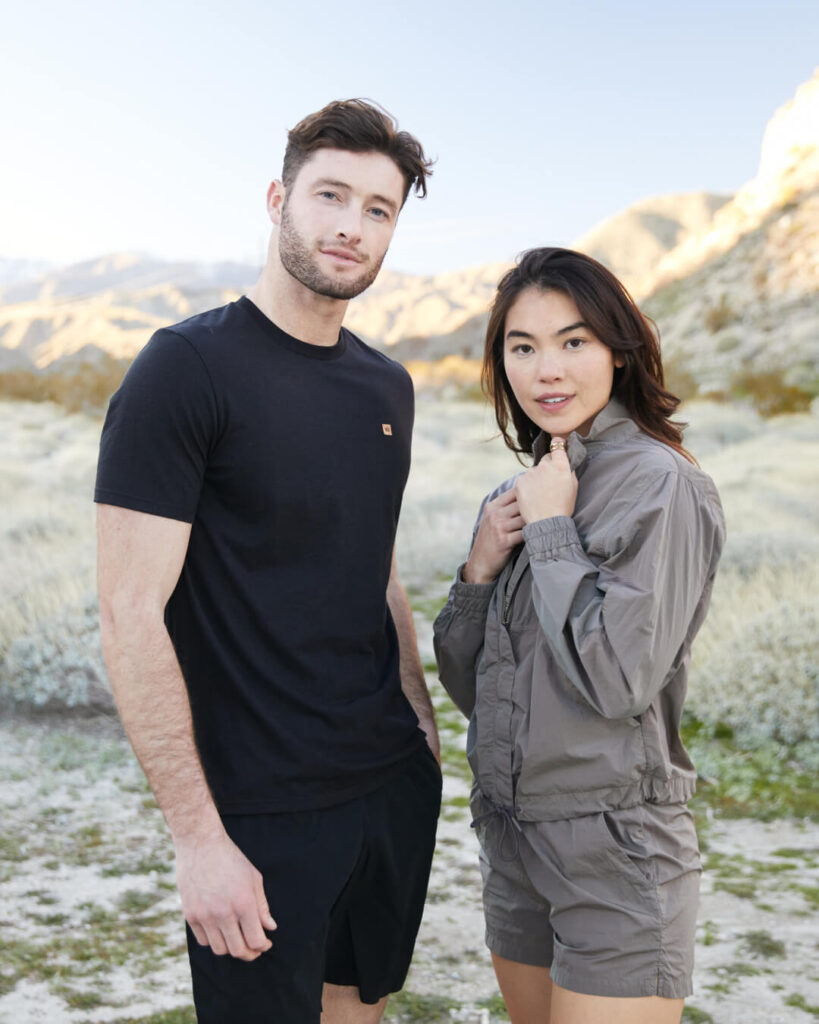
Tentree is a progressive clothing brand that has prioritised circularity in its mission to create low-impact products with an Earth-First approach. Apart from using eco-friendly renewable materials like organic cotton, recycled polyester, and TENCEL™ in its clothing line production, it plants ten trees for every order you make. In addition, Tentree promotes clothing repair and longevity through its partnership with SuperCircle and Treet. With the help of these circular initiatives, the label has created an all-in-one solution to keep your pre-loved items in circulation, ensuring nothing goes to waste.
Shop Tentree Here
3. The North Face

Sustainably-conscious The North Face is home to power-packed outdoor clothing that are made through innovative thinking, design, and technology. Dedicated to making the best functional and durable products on earth— every action taken by this label is focused towards safeguarding Mother Nature. Along with adding recycled materials as a vital part of its garment production, it has implemented recycling programs to give new life to old merchandise. While you can shop from its large collection of Circular Gear, it also has a “TNF Renewed” section which takes back and resells used TNF gears once you become a member.
4. A.BCH
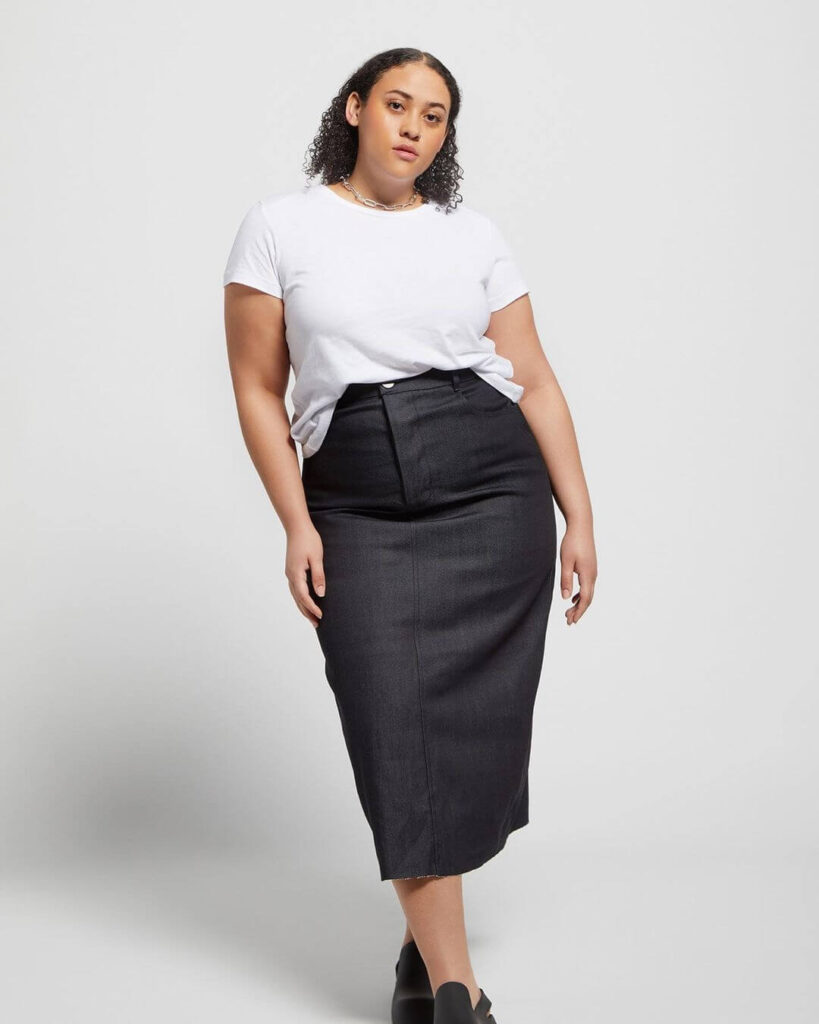
A.BCH, a fashion label based in Melbourne, Australia, caters to those who value the origin of their garments. With a strong commitment to circularity, the brand utilizes renewable, organic, and recycled materials in its clothing. Its mission is to revolutionize the way people engage with fashion, from purchasing to wearing and discarding. By focusing on every stage of the garment’s lifecycle, A.BCH strives to minimize material and energy waste. Despite its dedication to sustainability, it doesn’t compromise on style, offering beautifully designed clothing for customers to cherish. When the time comes, customers can drop off items for repair or return their worn-out garments for effective recycling.
5. Another Tomorrow
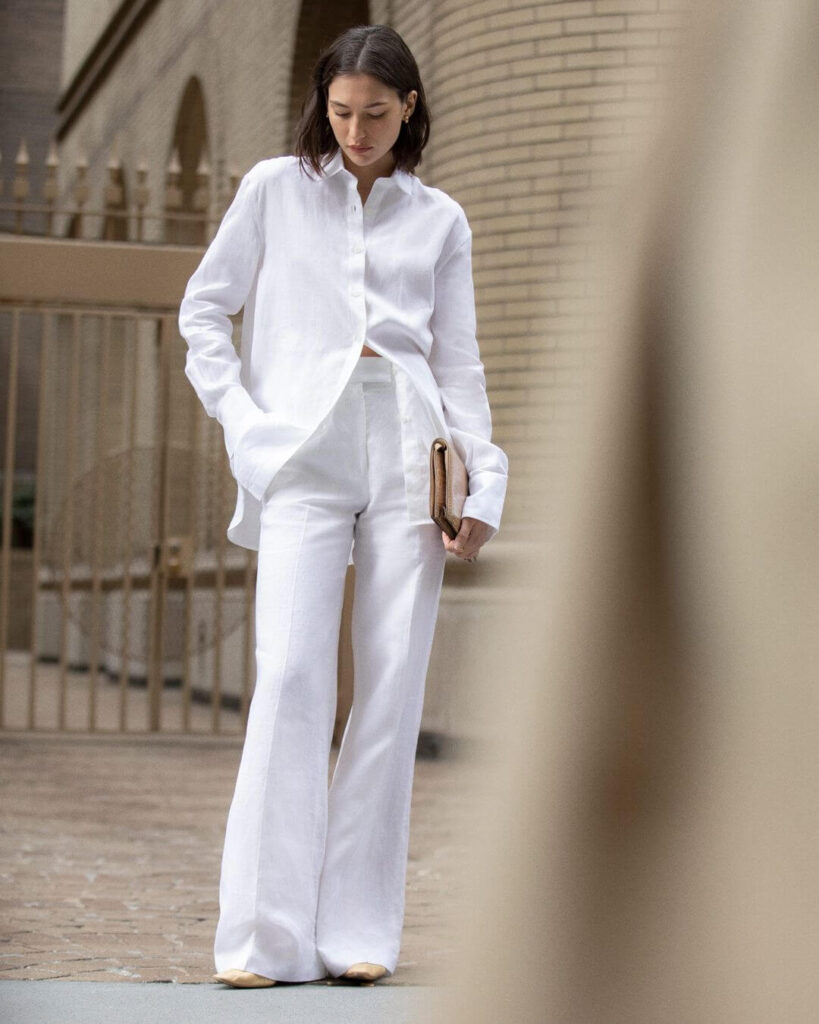
Another Tomorrow is one of the most mindful clothing brands that is built on a technology-based circular economy. Through innovative practices and a commitment to sustainable fashion, they prioritize the principles of a circular economy. Along with the use of renewable fabrics, the brand focuses on timeless designs and durable construction, ensuring that its clothing can be enjoyed for years to come. Additionally, the brand offers a take-back program through its “Authenticated Resale” section allowing customers to return their worn-out items or buy recycled garments. Another Tomorrow has also partnered with Recurate to boost this circular resale experience.
Brands Greenwashing Under the Guise of Circular Fashion
1. H&M
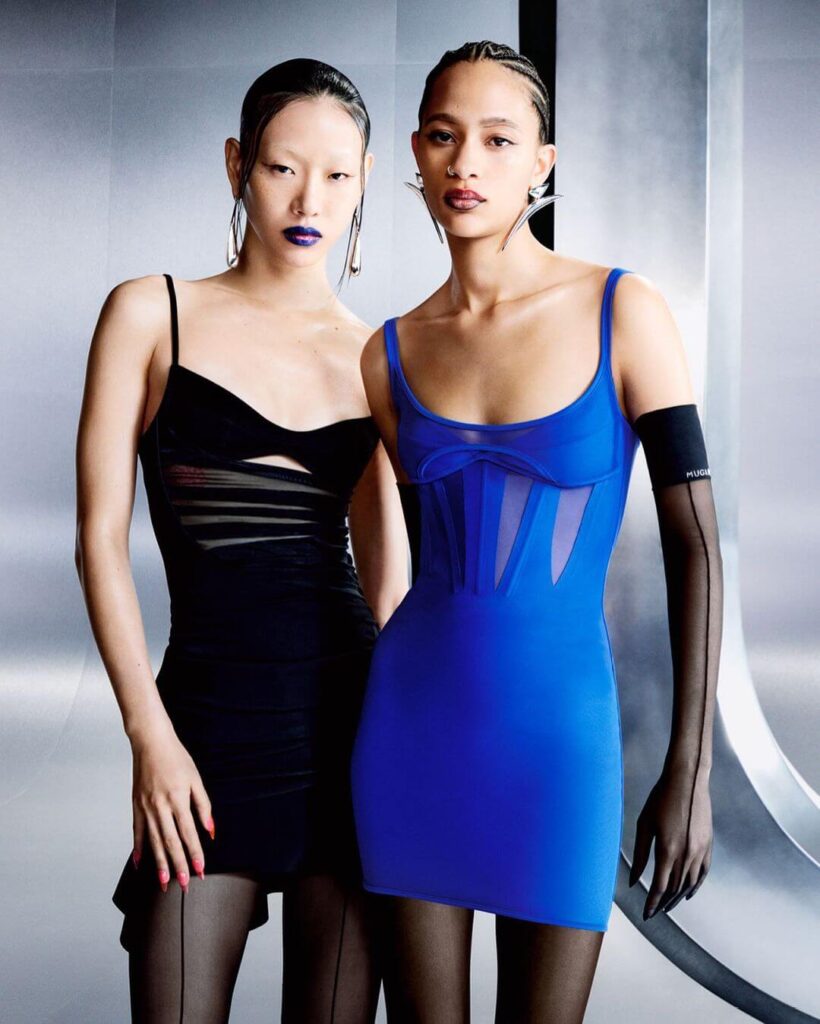
H&M claims to start with sustainability through its circular initiative, the “Conscious Collection,” which consists of garments made from at least 50% eco-friendly materials. However, it was found that most of the clothing in this collection are made from recycled polyester and nylon. While the Swedish brand advertised this section to be sustainable as it requires less water and energy consumption, it’s a known fact that recycling synthetics is resource-intensive. Besides, H&M’s main focus remains on producing low-quality, disposable garments at hefty volumes, contributing to the throwaway culture.
2. ASOS
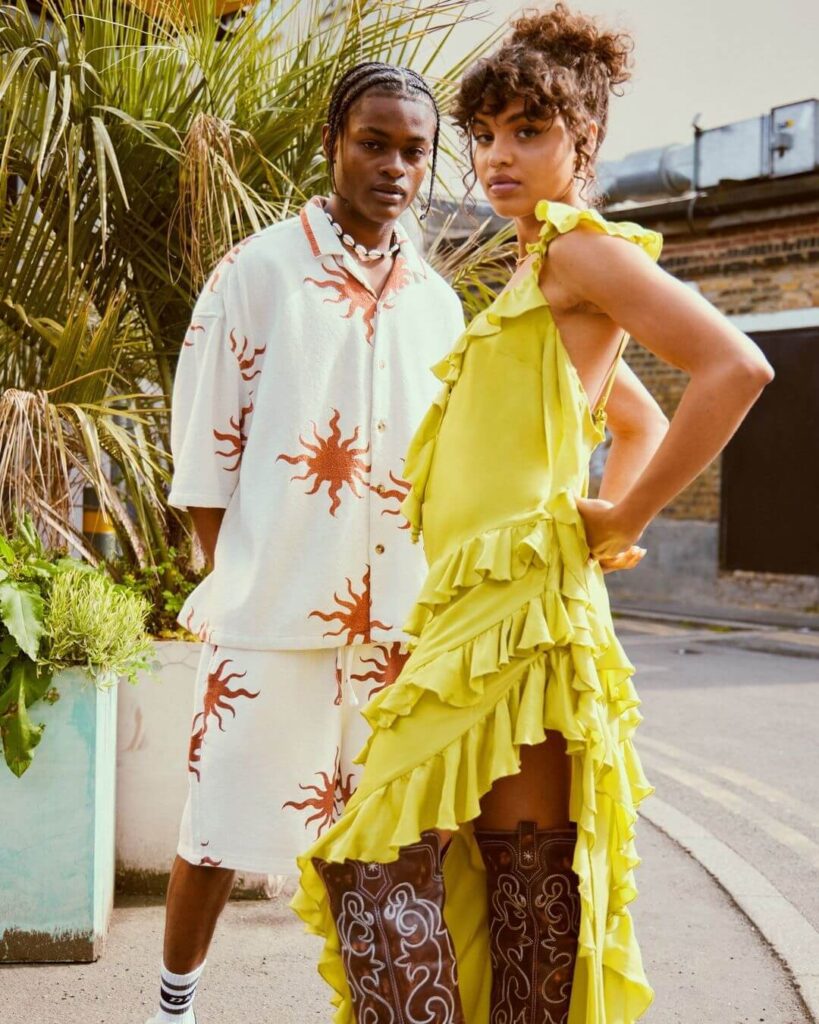
ASOS introduced its “Circular Collection” as part of an effort to portray itself as sustainable. However, compared to the marketplace’s extensive product range, this category only offered about 30 pieces of merchandise. Plus, some of the purses and bags in this category were made from harmful synthetic materials, which are extremely difficult to recycle. It also fails to provide transparent information about its supply chain and sourcing practices. ASOS has been called out by the media and several institutions, because of which the company silently removed that so-called “circular” line-up.
3. Lululemon

Lululemon has made claims about embracing circularity by introducing guest models that offer customers options to resell, repair, and recycle their products. However, the big question remains – is Lululemon fast fashion? Also, details and timeline for implementing these initiatives remain unclear, leaving their commitment somewhat vague. While it’s positive that Lululemon acknowledges the need to improve its environmental impact, there is a lack of concrete action behind their words. It’s essential for a global brand like Lululemon to provide more transparency and clarity regarding the infrastructure they plan to adopt and the specific timeframe for these sustainability efforts. The concept of a “valuable next life” for their products also remains undefined.
4. Zara
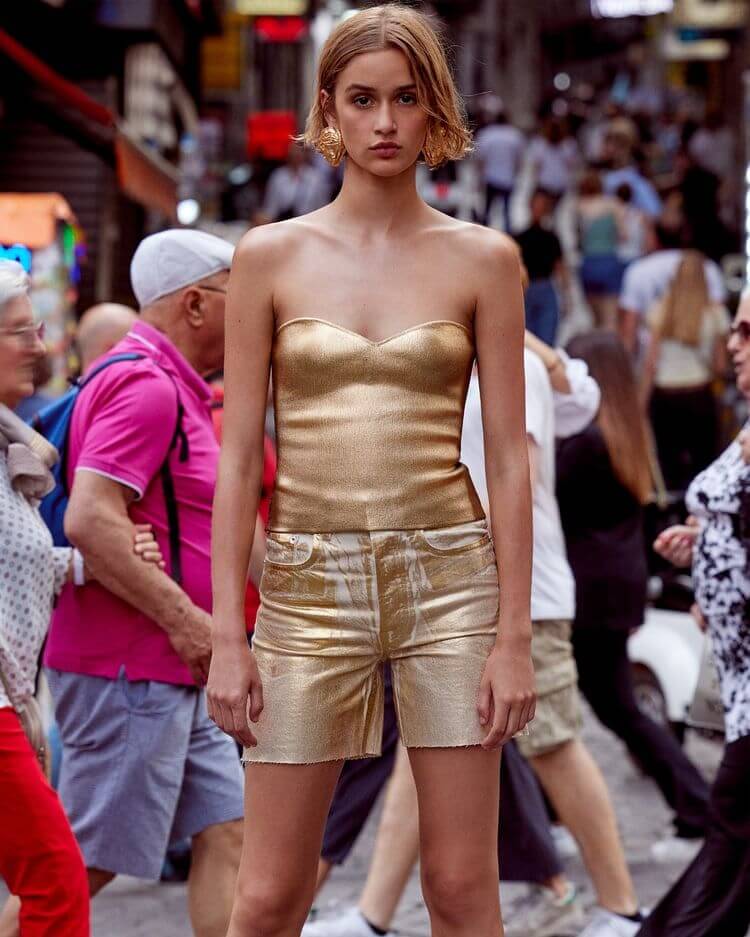
Zara, the OG of fast fashion, launched its “Join Life” product category, which comprises of clothing made from natural and recycled materials. Through this initiative, the company plans to move towards a circular economy. But just like most fast fashion brands trying to be sustainable, this collection from Zara showcases only a few products, which is almost negligible compared to its extensive inventory. So clearly, this approach fails to address the more significant issues of overproduction and overconsumption that the company promotes.
5. Shein

Shein is the most “searched and shopped from” fast fashion brands, right now. And why not? The Chinese label offers the trendiest of styles at dirt-cheap pricing. To take responsibility (or, let’s say, to act responsibly), the company launched a “Shein Exchange” platform. This space supposedly houses its secondhand items, which are up for sale at even lower costs. Shein mentions that this platform aims to encourage customers to actively participate in circularity and discover new wardrobes for their pre-loved items. Wow, sell millions of cheap clothing every year and preach about circularity. Only Shein can do this!
To Sum it Up…
Circular fashion holds immense potential to revolutionize the fashion industry. Through practices like designing for durability, incorporating timeless styles, embracing upcycled garments, and recycling leftover materials, we can transform the way we produce, consume, and dispose of clothing. Circular fashion not only addresses the negative impacts of the fashion industry, such as waste analysis, pollution, and resource exhaustion, but also opens doors for innovation, collaboration, and positive social change. It empowers everybody to make conscious choices, supports affordable, clothing sustainable brands and fosters a sense of collective responsibility. So, let’s join hands to make circular fashion systems the new norm and shape a future where fashion is both stylish and sustainable.





